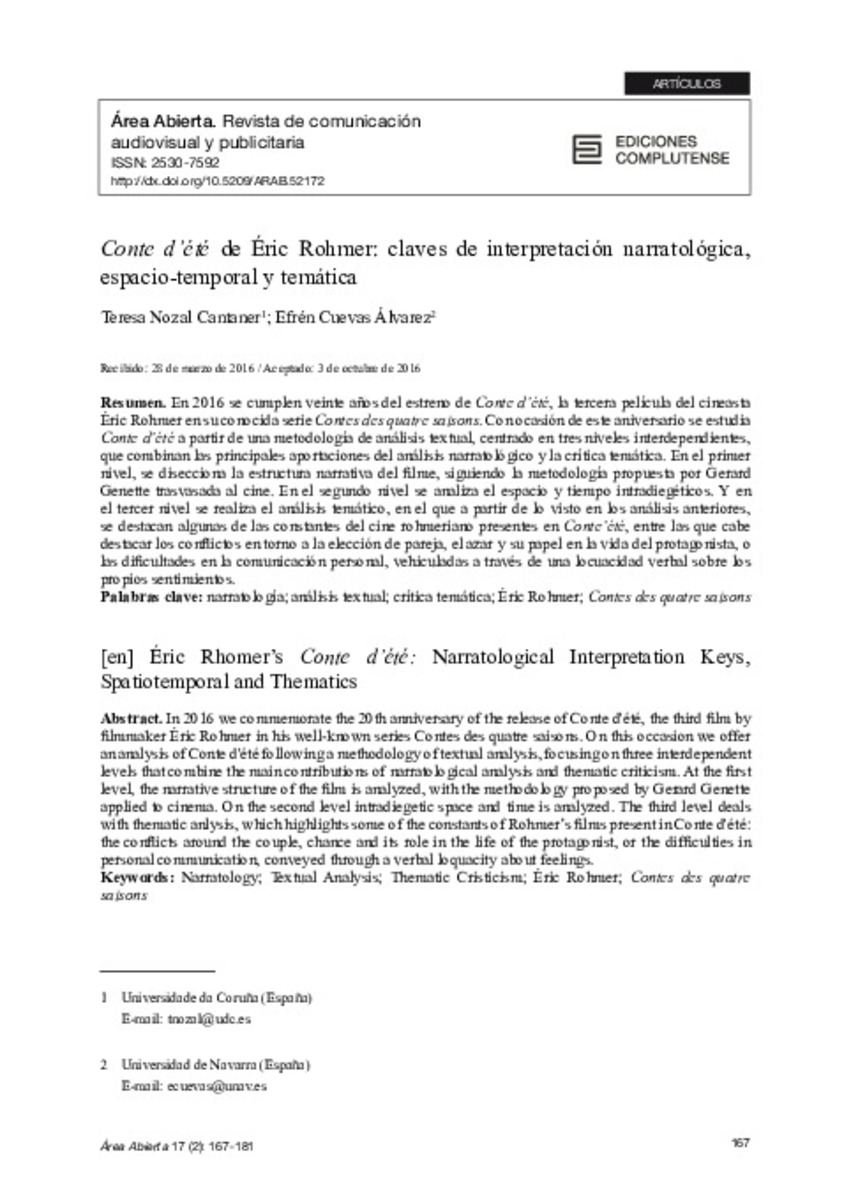Full metadata record
| DC Field | Value | Language |
|---|---|---|
| dc.creator | Nozal, T. (Teresa) | - |
| dc.creator | Cuevas, E. (Efrén) | - |
| dc.date.accessioned | 2017-09-18T10:03:11Z | - |
| dc.date.available | 2017-09-18T10:03:11Z | - |
| dc.date.issued | 2017 | - |
| dc.identifier.citation | Teresa Nozal y Efrén Cuevas, “Conte d'été de Éric Rohmer: claves de interpretación narratológica, espacio-temporal y temática”, Área Abierta, vol. 17, nº 2, pp. 167-181. | es_ES |
| dc.identifier.issn | 2530-7592 | - |
| dc.identifier.uri | https://hdl.handle.net/10171/43880 | - |
| dc.description.abstract | Resumen. En 2016 se cumplieron veinte años del estreno de Conte d’été , la tercera película del cineasta Éric Rohmer en su conocida serie Contes des quatre saisons. Con ocasión de este aniversario se estudia Conte d’été a partir de una metodología de análisis textual, centrado en tres niveles interdependientes, que combinan las principales aportaciones del análisis narratológico y la crítica temática. En el primer nivel, se disecciona la estructura narrativa del filme, siguiendo la metodología propuesta por Gerard Genette trasvasada al cine. En el segundo nivel se analiza el espacio y tiempo intradiegéticos. Y en el tercer nivel se realiza el análisis temático, en el que a partir de lo visto en los análisis anteriores, se destacan algunas de las constantes del cine rohmeriano presentes en Conte’été, entre las que cabe destacar los conflictos en torno a la elección de pareja, el azar y su papel en la vida del protagonista, o las dificultades en la comunicación personal, vehiculadas a través de una locuacidad verbal sobre los propios sentimientos. Abstract. In 2016 we commemorate the 20th anniversary of the release of Conte d'été, the third film by filmmaker Éric Rohmer in his well-known series Contes des quatre saisons. On this occasion we offer an analysis of Conte d'été following a methodology of textual analysis, focusing on three interdependent levels that combine the main contributions of narratological analysis and thematic criticism. At the first level, the narrative structure of the film is analyzed, with the methodology proposed by Gerard Genette applied to cinema. On the second level intradiegetic space and time is analyzed. The third level deals with thematic anlysis, which highlights some of the constants of Rohmer’s films present in Conte d'été: the conflicts around the couple, chance and its role in the life of the protagonist, or the difficulties in personal communication, conveyed through a verbal loquacity about feelings. | es_ES |
| dc.language.iso | spa | es_ES |
| dc.rights | info:eu-repo/semantics/openAccess | es_ES |
| dc.subject | Materias Investigacion::Comunicación::Comunicación audiovisual | es_ES |
| dc.subject | Cine, narratología, crítica temática | es_ES |
| dc.title | Conte d'été de Éric Rohmer: claves de interpretación narratológica, espacio-temporal y temática | es_ES |
| dc.type | info:eu-repo/semantics/article | es_ES |
| dc.relation.publisherversion | https://revistas.ucm.es/index.php/ARAB/article/viewFile/52172/51113 | es_ES |
| dc.publisher.place | Madrid | es_ES |
| dc.description.note | Creative Commons Reconocimiento 4.0 (CC BY 4.0) | es_ES |
| dadun.citation.endingPage | 181 | es_ES |
| dadun.citation.number | 2 | es_ES |
| dadun.citation.publicationName | Área abierta | es_ES |
| dadun.citation.startingPage | 167 | es_ES |
| dadun.citation.volume | 17 | es_ES |
Files in This Item:
Statistics and impact
Items in Dadun are protected by copyright, with all rights reserved, unless otherwise indicated.






